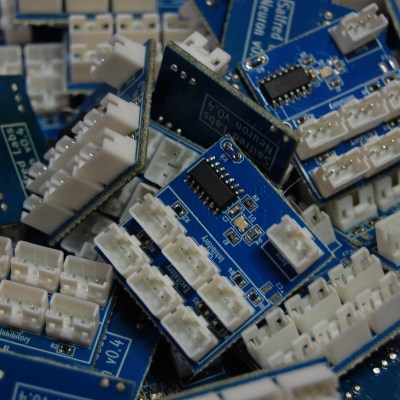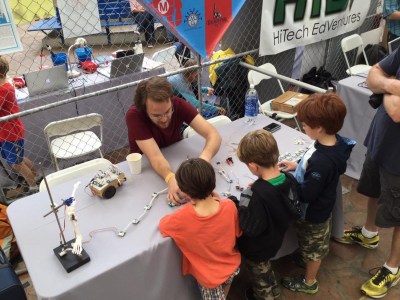What’s it like to build a run of 100 prototypes in your basement? Get a first-hand account as [Zach Fredin] discusses his development and production of NeuroBytes. The system is a set of electronic models that represent neurons. Connecting them together into different networks helps to teach about how the human nervous system works. It’s a wonderful concept, and was recognized as a finalist for Best Product in the 2015 Hackaday Prize. More recently, [Zach] tells us it has been granted Recommended Status for a Phase I SBIR National Science Foundation grant. Looks like [Zach’s] new job is all NeuroBytes and is well funded. Congratulations!
Check out [Zach Fredin’s] talk from the 2015 Hackaday SuperConference, then join us after the break to dig further into the details of the project.
If we gave out awards for longest SuperCon talk title, [Zach Fredin] would win: “You can take your hardware idea through pilot-scale production with minimal prior experience and not very much money, so you should do it NOW!”
That’s quite a mouthful, but then [Zach] has quite a lot to talk about. [Zach] learned to solder at 6 years old with the help of Heathkit videos. By 9th grade, he had discovered his parent’s driveway was in fact conductive when put up against a neon sign transformer. College found [Zach] falling out of the electronics hobby, as materials science caught his eye. Now, a decade later he’s back into it in a big way with NeuroBytes.
 [Zach’s] talk is all about how he ramped NeuroBytes from a breadboard project into pilot production. Zach is defining pilot as around 100 devices, so less than a shipping container, but more than 3 or 4. To do this, [Zach] leveraged tools that are available to every developer. He points out that EDA software like KiCad has made a big impact. Boards are also not as expensive as they used to be. Services like OSH Park and DirtyPCBs get us low-cost boards relatively quickly.
[Zach’s] talk is all about how he ramped NeuroBytes from a breadboard project into pilot production. Zach is defining pilot as around 100 devices, so less than a shipping container, but more than 3 or 4. To do this, [Zach] leveraged tools that are available to every developer. He points out that EDA software like KiCad has made a big impact. Boards are also not as expensive as they used to be. Services like OSH Park and DirtyPCBs get us low-cost boards relatively quickly.
At this point, some hackers would take the route of going to an assembly house. Zach decided to build his pilot run in his basement. NeuroBytes has a relatively small number of parts, so it wouldn’t take too long to assemble each board. Applying solder paste was a bit of a chore. [Zach] quickly learned to always spring for a stencil. Soldering the surface mount parts was made much easier with the help of a toaster oven reflow setup. You can find plenty of projects to convert your own oven over on Hackaday.io.
 The result of [Zach’s] experiment into pilot production was a wild success. He manged to build all 100 boards at a cost of just $4.79 each. This volume of boards was plenty to share with his collaborators. [Zach] had enough left that he was able to bring a bunch of NeuroBytes to San Diego Makerfaire with no worries about kids breaking the units. When you only have one or two copies of your project, they’re more valuable than gold. If you have 100, it’s much easier to hand them off to kids for stress testing.
The result of [Zach’s] experiment into pilot production was a wild success. He manged to build all 100 boards at a cost of just $4.79 each. This volume of boards was plenty to share with his collaborators. [Zach] had enough left that he was able to bring a bunch of NeuroBytes to San Diego Makerfaire with no worries about kids breaking the units. When you only have one or two copies of your project, they’re more valuable than gold. If you have 100, it’s much easier to hand them off to kids for stress testing.
We want to thank [Zach] for his talk, and for sticking around to hack out a NeuroByte enabled badge in our badge hacking competition.

















not a hack
Hush, you! :P
I beg to differ. Putting together 100 copies of a PCBA in your basement by hand is definitely hacking. Just manufacturing hacking.
hackaday = one hack a day. The quota has been met elsewhere.
Check on http://www.hacksaday.com/
We don’t need another domain. We’re saving up for hackaday.sucks, anyway. You know, get ahead of the pack or something
Nah, go for hackaday.rocks. It’s still available, and if you don’t take it then I’ll snag it and use it for a fan site…….ah, even better! A hackaday satire site!
To Rodney McKay
So that satire site, hackaday.rocks, would be about beating hacks with rocks?
Anyone could have registered that and redirected it to a video of Rick Astley dancing. I am so disappointed.
And now that song is stuck in my head. Self-roll.
You win the internet Zach. Well played. By far my favorite comment of the year!
I agree that this isn’t a hack for you knitpickers but it does give info to hackers that may want to start getting into a manufacturing process of something may have designed or designed something that is used to hack something else. In that case I do think this is a perfect place to share and gain knowledge of such a thing. Isn’t that what hacking/open source is all about. I don’t know, I could be wrong but that’s what I thought it meant…
Do these do something useful? Seriously, I’m asking. Cos you wouldn’t normally make a neural network by connecting up hundreds of separate neuron PCBs, you’d do it with a computer. What’s the advantage to making these?
Um, did you actually watch the video, Greenaum? My takeaway is at two levels. 1) The goal of the project is not to make a neural network – the goal is to make (inspire the growth of) neuroscientists. 2) To inspire and encourage some of us to get out from behind the laptop, and go into the basement and use persistence to MAKE SOMETHING HAPPEN.
Nope, on a slow mobile connection, I can only watch videos at certain times of day, when everyone else stops using the bandwidth.
It’s a great point–you could emulate a network many orders of magnitude more complex in a single chip with faster response time and lower power requirements. We’re hoping to use the system primarily for neuroscience education, where the hands-on nature of the platform makes up for its simplicity.
Do you get results? Not necessarily useful ones, but do patterns emerge and stuff, can you show principles? I suppose I need to go look…
The v04 prototypes (the blue squares I discussed in the video) are pretty basic; in neuroscience terms, they’ve each got six dendrites and a single axon terminal that can be split externally to feed additional devices. The firmware uses static weighting on each input (70% of the action potential threshold, meaning each one needs two excitatory inputs to fire). Networks with more than 8-10 elements certainly show interesting patterns, although they’re mostly a nifty light show at this point–the patterns’ unpredictability is a result of subtle timing differences between microcontrollers.
Using the current generation, we’ve been able to demonstrate basic principles like excitation, inhibition, refractory periods, that sort of thing. We can build primitive central pattern generation circuits and connect to “sensory elements”–proximity switches, light sensors, etc. Our patellar reflex demonstration, which uses 3D printed bones and servo “muscles”, was a big hit at SD Maker Faire–I’m confident that a decent number of young neuroscientists-to-be learned _something_ new about physiology.
The focus of the SBIR discussed in the article is to study the educational efficacy of the patellar demonstration in an introductory undergraduate A&P course. We’ll have a lot more data in six months, along with a platform that can (hopefully) show much more advanced functionality–backpropagation, spacial summation, neuroplasticity, that sort of thing. So.. stay tuned, I guess?
Modern manufacturing techniques push for one-piece-flow and no WIP. This way you only build full orders then ship em. Parts stay as parts and your capital is not tied up in half completed material that cant be sold or is waiting for a purchase order.
EVERYONE I’ve ever seen build a few PCBs does batch-n-push, which is the opposite. When you get into higher volume production you have to consider tying up your capital.
What kind of automation does that kind of manufacturing have? How much investment is needed?